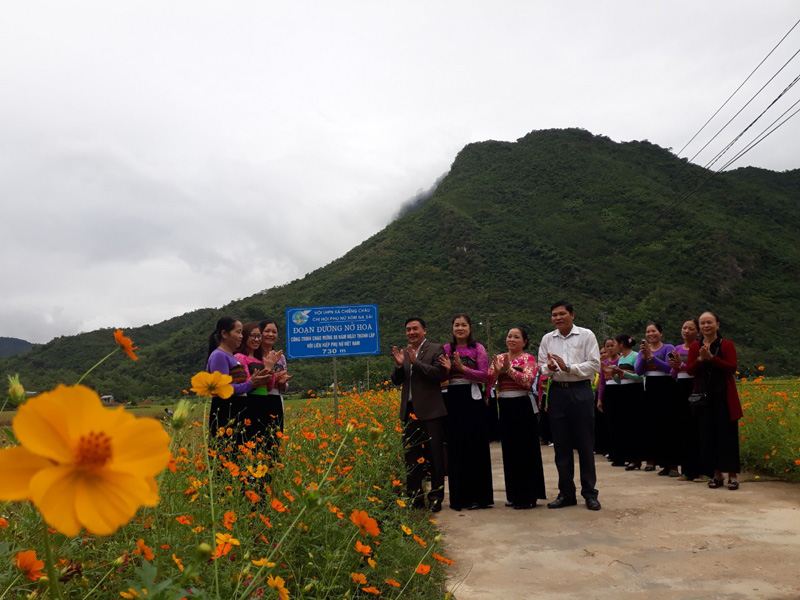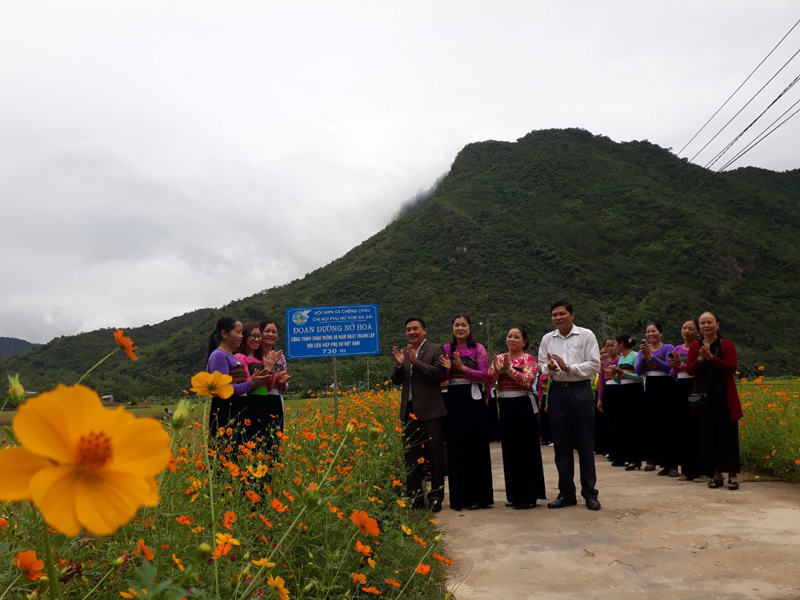
(HBO) - Recently, the movement of turning waste collection areas and weed paths into "flowering sections" have been actively implemented by the Women's Union of Mai Chau district.

Over the past few years, in order to promote
the role of staff and women members in protecting environment and building the
green- clean- beautiful scenes, the District Women's Union has launched a
campaign "Every woman member planted a flower". The first model was
implemented from January 2018, until now, the whole district had 13/23 communes
and towns implementing the campaign.
On these days, the 730- meter road leading
from National Highway 15 into Na Sai village, Chieng Chau commune is like
wearing a new more brilliant coat by being prominent between two rice fields
with a colorful road in a variety of flower species, such as butterfly wings,
white flowers, violet flowers, etc. These are all flowers with good vitality,
easy to grow, easy to care, and they can bloom all around the year and in
accordance with the cultural identity of the site. Many groups and women's
unions activities have been flexible, creative and supported by local
committees, local authorities and enthusiastic participation of local people,
such as they plant flowers at the sections where they often waste garbage,
causing bad appearance and environmental pollution.
Ms Ha Thi Yen – the Chairwoman of Chieng Chau
Commune Women's Union said: "Right after the district Women's Union
launched the movement" Every woman member planted a tree", Chieng
Chau Commune Women's Union quickly deployed to each branch, each members of the
whole commune and received the active response of most members participating.
Some contributed their efforts, some contributed their money to purchase flower
seedlings, etc., so far, the commune has built two long "flowering
roads" in Na Sai hamlet and Lac village, while in other hamlets, women
have planted around their houses and around the area of the cultural houses of
the village."
With an increasingly vibrant and widespread emulation movement aimed at building cultured residential areas and cultured families, Yen Thuy District has been making steady progress toward improving both the material and spiritual well-being of its people, while fostering a civilized, prosperous, beautiful, and progressive community.
Once lacking recreational spaces and community facilities, Residential Group 2 in Quynh Lam Ward (Hoa Binh City) has recently received attention for the construction of a new, spacious, and fully equipped cultural house. The project followed the model of state support combined with public contributions in both labor and funding.
The "All people unite to build cultural life" movement, which has been effectively integrated with Kim Boi district’s socio-economic development goals, is fostering a lively spirit of emulation across local residential areas, hamlets, villages, public agencies, and enterprises. In addition, through the initiative, traditional cultural values are being preserved and promoted, while community solidarity and mutual support in poverty reduction and economic development are being strengthened.
A working delegation of the Hoa Binh provincial People’s Committee led by its Permanent Vice Chairman Nguyen Van Toan on June 11 inspected the progress of a project to build the Mo Muong Cultural Heritage Conservation Space linked to tourism services in Hop Phong commune, Cao Phong district.
Born and growing in the heroic land of Muong Dong, Dinh Thi Kieu Dung, a resident in Bo town of Kim Boi district, in her childhood was nurtured by the sweet lullabies of her grandmother and mother. These melodies deeply imprinted on her soul, becoming an inseparable part of her love for her ethnic group's culture. For over 20 years, this love for her hometown has driven Dung to research, collect, and pass down the cultural values of the Muong people to future generations.
In the final days of May, the Ethnic Art Troupe of Hoa Binh Province organized performances to serve the people in remote, mountainous, and particularly disadvantaged areas within the province. These were not just ordinary artistic shows, but they were the meaningful journeys aimed at spreading cultural values, enhancing the spiritual life of the people and contributing to the preservation of ethnic minority cultural identities.



